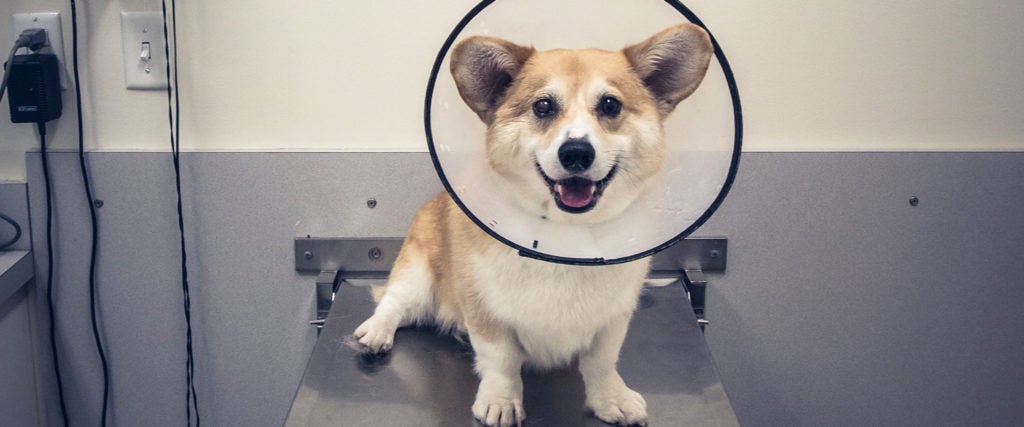You say your dog needs to go to the vet, but they say, “There are too many weird smells there, the other dogs are too damn loud, some guy in a white coat pricked me with a freaking needle last time, and I never want a thermometer in my butt ever again.”
On the one hand, yeah, you feel for your pooch and understand that going to the vet is kinda stressful. On the other, regular vet visits are essential to their livelihood and general welfare, something they may not quite understand. What they will understand, though, are the following things you can do to keep your dog calm and content while they endure pesky visits to the vet.
- Read Next: Why Are Dogs Afraid of Hats?
Find a Good Vet and Hold Them Dear
The best way to ensure your dog has a good time at the vet is to find someone they can look forward to visiting on occasion. “Find a vet that you like, and try to see the same vet every time so that your dog gets to know them,” says Zazie Todd, animal psychologist and author of Wag: The Science of Making Your Dog Happy. “This is especially important at the moment when you may not be able to go into the vet with your dog because of the pandemic.”
If you need help finding a good vet, look for those certified as “Fear Free,” which means they take extra care to keep your pet calm during their visit. “These clinics are dedicated to reducing the fearfulness of the veterinary encounter by trying to control potential stressors — loud noise, lots of activity, scary smells, slippery exam tables,” says Jessica Pierce, bioethicist and author of numerous books about pets, including Unleashing Your Dog: A Field Guide to Giving Your Canine Companion the Best Possible Life. “They try to move more slowly through the physical exam, ask dogs for ‘consent’ rather than using physical restraint and allow dog patients the time they need to get comfortable.”
If your dog is still scared of the vet, Todd says, “See if your vet allows visits in which nothing happens other than the pup having treats, pets and a generally nice time.” This can help them associate the vet with good times, as opposed to having the aforementioned thermometers put in their butts. And if your dog hates all the barking and smells in the waiting room, ask if they can wait in the car until the time of their appointment (and maybe play some of their favorite music, too).
Provide Treats and Belly Rubs
“In normal times, when you’re allowed in with your dog, you can help them with gentle petting and talking nicely to them,” Todd says. “Research shows that this can help dogs to be less stressed. But don’t hold their collar or muzzle, because dogs generally don’t like that. You can also take really nice food treats to give them during the consult, so long as it’s okay with your vet. If anything scary, or potentially scary, happens, like an injection, offer your dog treats immediately afterwards. Even if they’re too stressed to eat them at the time, they may still eat them before the end of the consultation.”
Do Some Training
“If you have a puppy, look for a puppy class that includes some handling exercises,” Todd recommends. “When doing these exercises, make sure the puppy always has a choice, use a gradual plan that starts with very easy steps, watch the puppy for signs of stress — and stop immediately if they seem stressed — and use treats, petting and play to make it a fun game for your pup.”
You can train adult dogs, too, but it might take a little more work. “If you want to work on your own, the Husbandry Project from the Academy for Dog Trainers has a set of free training plans that go from basics right through to behaviors helpful for specialist veterinary care,” Todd says. “There are also online courses in cooperative care, such as the tooth-brushing course from Doggy Geeks University or Ready, Set for Groomer and Vet from Animal Behavior Training Concepts.”
If All Else Fails, a Muzzle May Be Needed
If your dog freaks out like no other when taken to the vet, you may need to strap them up with a muzzle. “Sometimes dogs have to wear a muzzle at the vet, so you can help by training them to wear a muzzle in advance,” Todd says. “Follow a gradual training plan and use really great treats — for example, you can put peanut butter on the muzzle before you show it to your dog, but check that the peanut butter doesn’t contain xylitol, an artificial sweetener that’s poisonous to dogs. The Muzzle Up! Project has some great resources on muzzle training.”
And Lastly, Calm Down — Yeah, You
If you want your dog to chill, you need to chill first. “Try to stay calm yourself, so your dog doesn’t pick up on your nervousness,” Pierce suggests.
I know needles aren’t your thing, but your dog needs you right now.

